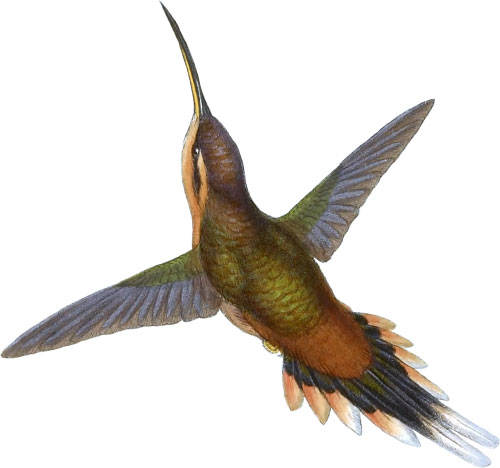It would appear that some of the smaller members of the genus Phaëthornis have the lower part of the back and upper tail-coverts buff, while in others those parts are uniform with the upper surface; it is the latter style of colouring which prevails in the bird here figured.
Its native country is the interior, and I believe the western parts, of Brazil; but its range may extend to the confines of Peru, for there is a specimen in the Museum at Neufchâtel, procured by Dr. Tschudi, with the name of pygmæus of Spix attached to it, which, if not identical with this bird, is most closely allied to it.
As will be seen on reference to the accompanying Plate, the Phaëthornis viridicaudata is a very pretty species, rendered conspicuous by the rich colouring of the chest and the rather lengthened form of its tail. The two specimens in my collection are all that have come under my notice, unless the bird procured by Dr. Tschudi should prove to be the same.
Stripe over and behind the eye buff; crown of the head, upper surface and wing-coverts bronzy grassgreen, duller on the head; wings purplish brown; tail-feathers bronzy grass-green at the base, passing into dark brown towards the extremity, the central feathers tipped with white, and the remainder with white on the apical portion of the external web; chest reddish buff, becoming paler on the abdomen and vent; an obscure light grey stripe below the eye; upper mandible black; basal two-thirds of the lower mandible yellow, tip black; legs yellow.
The figures are of the natural size. The plant is the Galipea macrophylla.
 Phaëthornis Longuemareus
Longuemare’s Hermit
Phaëthornis Longuemareus
Longuemare’s Hermit
 Phaëthornis Amaura
Amaura Hermit
Phaëthornis Amaura
Amaura Hermit
 Paëthornis zonura
Southern Hermit
Paëthornis zonura
Southern Hermit
 Phaëthornis Adolphi
Adolph’s Hermit
Phaëthornis Adolphi
Adolph’s Hermit
 Phæthornis griseogularis
Grey-throated Hermit
Phæthornis griseogularis
Grey-throated Hermit
 Phaëthornis striigularis
Stripe-throated Hermit
Phaëthornis striigularis
Stripe-throated Hermit
 Phaëthornis obscura
Obscure Hermit
Phaëthornis obscura
Obscure Hermit
 Phaëthornis nigricinctus
Belted Hermit
Phaëthornis nigricinctus
Belted Hermit
 Phaëthornis Episcopus
Bishop Hermit
Phaëthornis Episcopus
Bishop Hermit
 Phaëthornis Eremita
Little Hermit
Phaëthornis Eremita
Little Hermit
 Phaëthornis pygmæus
Pigmy Hermit
Phaëthornis pygmæus
Pigmy Hermit
Featuring all 422 illustrated species from John Gould’s A Monograph of the Trochilidæ, or Family of Humming-Birds arranged by color.